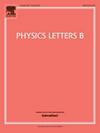重新审视NMSSM中的电子电火花加工
IF 4.5
2区 物理与天体物理
Q1 ASTRONOMY & ASTROPHYSICS
引用次数: 0
摘要
具有显式CP破坏的次极小超对称标准模型(NMSSM)为解释观测到的重子不对称性提供了一个有希望的框架,同时保持了严格的电偶极矩(EDM)界限的一致性。在这项工作中,我们确定了一组以前被忽视的双环图,它们有助于NMSSM中的费米子edm。我们对电子电火花加工的分析表明,对于某些NMSSM特定的cp违反相,这些图部分地抵消了现有的贡献,从而放松了相关的约束。在其他阶段,图占据主导地位并收紧边界,这反过来又需要更精细的参数来协调成功的重子发生与当前的EDM极限。本文章由计算机程序翻译,如有差异,请以英文原文为准。
Revisiting the electron EDM in the NMSSM
The Next-to-Minimal Supersymmetric Standard Model (NMSSM) with explicit CP violation offers a promising framework for explaining the observed baryon asymmetry while remaining consistent with stringent electric dipole moment (EDM) bounds. In this work, we identify a previously overlooked set of two-loop diagrams that contribute to fermion EDMs in the NMSSM. Our analysis of the electron EDM shows that, for certain NMSSM specific CP-violating phases, these diagrams partially cancel existing contributions, thereby relaxing the associated constraints. In other phases, the diagrams dominate and tighten the bounds, which in turn necessitates more finely tuned parameters to reconcile successful baryogenesis with current EDM limits.
求助全文
通过发布文献求助,成功后即可免费获取论文全文。
去求助
来源期刊

Physics Letters B
物理-物理:综合
CiteScore
9.10
自引率
6.80%
发文量
647
审稿时长
3 months
期刊介绍:
Physics Letters B ensures the rapid publication of important new results in particle physics, nuclear physics and cosmology. Specialized editors are responsible for contributions in experimental nuclear physics, theoretical nuclear physics, experimental high-energy physics, theoretical high-energy physics, and astrophysics.
 求助内容:
求助内容: 应助结果提醒方式:
应助结果提醒方式:


